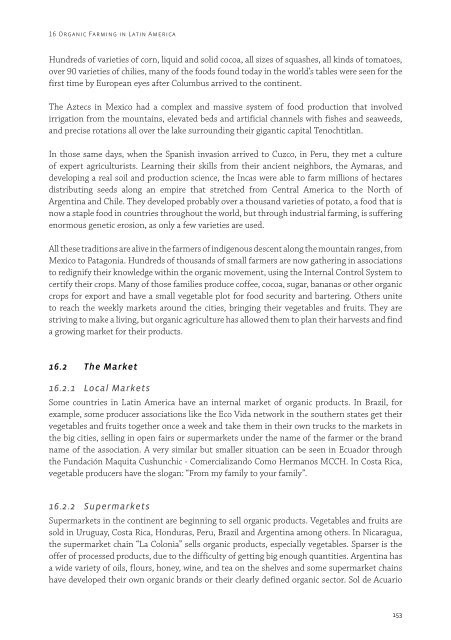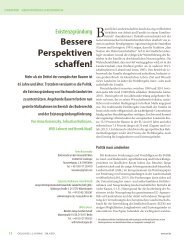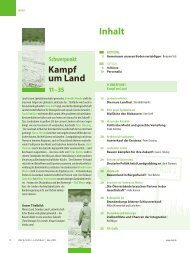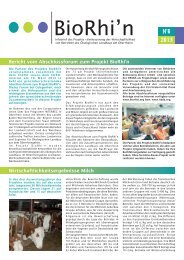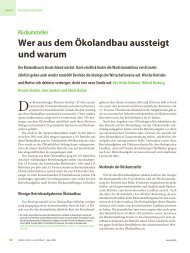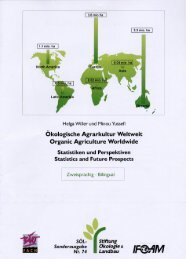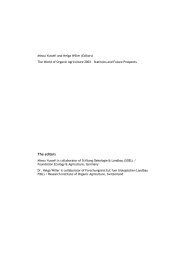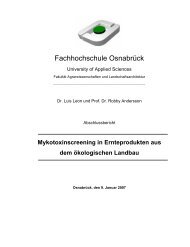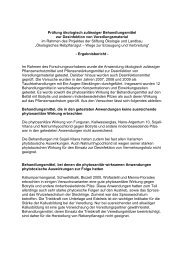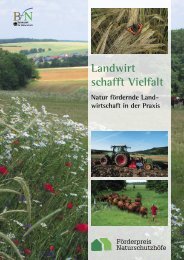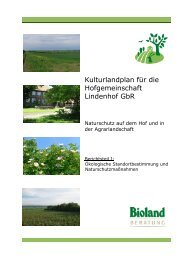the world of organic agriculture - Organic Eprints
the world of organic agriculture - Organic Eprints
the world of organic agriculture - Organic Eprints
Create successful ePaper yourself
Turn your PDF publications into a flip-book with our unique Google optimized e-Paper software.
16 <strong>Organic</strong> Farming in Latin America<br />
Hundreds <strong>of</strong> varieties <strong>of</strong> corn, liquid and solid cocoa, all sizes <strong>of</strong> squashes, all kinds <strong>of</strong> tomatoes,<br />
over 90 varieties <strong>of</strong> chilies, many <strong>of</strong> <strong>the</strong> foods found today in <strong>the</strong> <strong>world</strong>’s tables were seen for <strong>the</strong><br />
first time by European eyes after Columbus arrived to <strong>the</strong> continent.<br />
The Aztecs in Mexico had a complex and massive system <strong>of</strong> food production that involved<br />
irrigation from <strong>the</strong> mountains, elevated beds and artificial channels with fishes and seaweeds,<br />
and precise rotations all over <strong>the</strong> lake surrounding <strong>the</strong>ir gigantic capital Tenochtitlan.<br />
In those same days, when <strong>the</strong> Spanish invasion arrived to Cuzco, in Peru, <strong>the</strong>y met a culture<br />
<strong>of</strong> expert agriculturists. Learning <strong>the</strong>ir skills from <strong>the</strong>ir ancient neighbors, <strong>the</strong> Aymaras, and<br />
developing a real soil and production science, <strong>the</strong> Incas were able to farm millions <strong>of</strong> hectares<br />
distributing seeds along an empire that stretched from Central America to <strong>the</strong> North <strong>of</strong><br />
Argentina and Chile. They developed probably over a thousand varieties <strong>of</strong> potato, a food that is<br />
now a staple food in countries throughout <strong>the</strong> <strong>world</strong>, but through industrial farming, is suffering<br />
enormous genetic erosion, as only a few varieties are used.<br />
All <strong>the</strong>se traditions are alive in <strong>the</strong> farmers <strong>of</strong> indigenous descent along <strong>the</strong> mountain ranges, from<br />
Mexico to Patagonia. Hundreds <strong>of</strong> thousands <strong>of</strong> small farmers are now ga<strong>the</strong>ring in associations<br />
to redignify <strong>the</strong>ir knowledge within <strong>the</strong> <strong>organic</strong> movement, using <strong>the</strong> Internal Control System to<br />
certify <strong>the</strong>ir crops. Many <strong>of</strong> those families produce c<strong>of</strong>fee, cocoa, sugar, bananas or o<strong>the</strong>r <strong>organic</strong><br />
crops for export and have a small vegetable plot for food security and bartering. O<strong>the</strong>rs unite<br />
to reach <strong>the</strong> weekly markets around <strong>the</strong> cities, bringing <strong>the</strong>ir vegetables and fruits. They are<br />
striving to make a living, but <strong>organic</strong> <strong>agriculture</strong> has allowed <strong>the</strong>m to plan <strong>the</strong>ir harvests and find<br />
a growing market for <strong>the</strong>ir products.<br />
16.2 The Market<br />
16.2.1 Local Markets<br />
Some countries in Latin America have an internal market <strong>of</strong> <strong>organic</strong> products. In Brazil, for<br />
example, some producer associations like <strong>the</strong> Eco Vida network in <strong>the</strong> sou<strong>the</strong>rn states get <strong>the</strong>ir<br />
vegetables and fruits toge<strong>the</strong>r once a week and take <strong>the</strong>m in <strong>the</strong>ir own trucks to <strong>the</strong> markets in<br />
<strong>the</strong> big cities, selling in open fairs or supermarkets under <strong>the</strong> name <strong>of</strong> <strong>the</strong> farmer or <strong>the</strong> brand<br />
name <strong>of</strong> <strong>the</strong> association. A very similar but smaller situation can be seen in Ecuador through<br />
<strong>the</strong> Fundación Maquita Cushunchic - Comercializando Como Hermanos MCCH. In Costa Rica,<br />
vegetable producers have <strong>the</strong> slogan: “From my family to your family”.<br />
16.2.2 Supermarkets<br />
Supermarkets in <strong>the</strong> continent are beginning to sell <strong>organic</strong> products. Vegetables and fruits are<br />
sold in Uruguay, Costa Rica, Honduras, Peru, Brazil and Argentina among o<strong>the</strong>rs. In Nicaragua,<br />
<strong>the</strong> supermarket chain “La Colonia” sells <strong>organic</strong> products, especially vegetables. Sparser is <strong>the</strong><br />
<strong>of</strong>fer <strong>of</strong> processed products, due to <strong>the</strong> difficulty <strong>of</strong> getting big enough quantities. Argentina has<br />
a wide variety <strong>of</strong> oils, flours, honey, wine, and tea on <strong>the</strong> shelves and some supermarket chains<br />
have developed <strong>the</strong>ir own <strong>organic</strong> brands or <strong>the</strong>ir clearly defined <strong>organic</strong> sector. Sol de Acuario<br />
153


